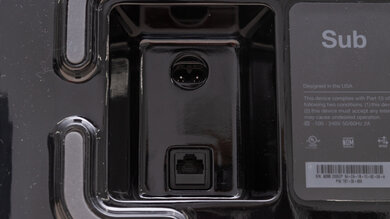Our Verdict
Decent for mixed usage. The Samsung HW-Q60R soundbar will perform quite well with different types of content. Its sound profile is fairly neutral and accurate, although it does lack a bit of sub-bass, which will be noticeable on movies and bass-heavy music. The HW-Q60R has a very good reproduction of vocals and voices, which is suitable for dialogue-centered content like audiobooks and podcasts. Unfortunately, it doesn’t support Atmos and height channels for a more immersive listening experience. On the upside, the bar can get pretty loud regardless of the content you’re playing.
- Decent stereo sound profile.
- Very well-built design.
- Decent overall performance at high volume.
- No height channels and Atmos support.
- Lacks sub-bass.
Good for dialogue and TV shows. The Samsung Q60R soundbar has a great stereo frequency response with an accurate reproduction of voices and dialogue in movies. It will be a good option for listening to audiobooks and podcasts too. The bar can get very loud too and has a dialogue enhancement feature. Also, it’s quite easy to stream content wirelessly to the bar via Bluetooth.
Decent for music. The Q60R soundbar has a pretty good stereo frequency response, but its bass isn’t that extended, which can hurt its performance on bass-heavy genres. However, it'll be suitable for most music. Unfortunately, the soundstage isn’t the widest but still is decently wide. On the other hand, the bar can get very loud and performs quite well at max volume too.
Passable for movies. The Samsung Q60R soundbar sounds decent but might lack a bit of sub-bass for movies. On the upside, it can get very loud and performs quite well without too much compression at max volume. While it does support surround sound content, this soundbar won’t offer the most immersive experience. It also doesn’t support Atmos and height channels.
Changelog
- Updated Mar 31, 2021: Converted to Test Bench 1.0.
- Updated Sep 27, 2019: Review published.
Check Price
Popular Soundbar Comparisons
The Samsung HW-Q60R is a decent mixed-usage soundbar that has a unique Acoustic Beam design by Samsung which helps with surround performance. It's well-designed and has a decent stereo audio quality as well, but doesn't support Atmos like other higher-hand models in the lineup. See our recommendations for the best soundbars, the best Dolby Atmos soundbars, and the best soundbars for music.
The Samsung HW-Q70R is an overall better-sounding soundbar setup than the Samsung HW-Q60R. The Q70R has a better stereo performance and it also supports Atmos, which the Q60R can’t do. However, the Q60R can play surround content while the Q70R can't. On the other hand, the Q70R has more audio formats supported and can also be used via Wi-Fi.
The standalone Sonos Arc is better for mixed usage than the Samsung HW-Q60R. The Sonos supports Dolby Atmos content and has built-in voice assistant support. It comes with room correction and has better surround and soundstage performances. However, the Samsung is more customizable thanks to its graphic EQ and presets.
Although the Samsung HW-Q60T is the newer model of the Samsung HW-Q60R, the older model still slightly outperforms the 2020 model. The HW-Q60R is better for dialogue thanks to its center channel performance, and its surround channel is slightly less bass-heavy. However, unlike other Samsung soundbars, including the HW-Q60R, the HW-Q60T lacks a companion app.
The Samsung HW-Q60R and the LG SK9Y have similar performance in mixed usage. The Samsung has a much better build quality, better center channel performance, and is more customizable; however, the LG has up-firing speakers to simulate height in Dolby Atmos content, has Chromecast built-in, and has more input selection.
Test Results





























